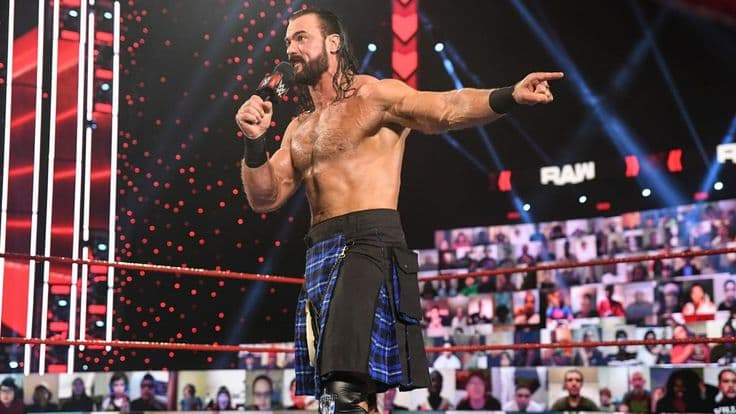Drew McIntyre, one of WWE’s most respected and battle-tested veterans, recently dropped a provocative statement that has stirred conversations backstage and among fans alike. In a candid interview, the former WWE Champion asserted that “85% of our guys don’t look like they should be in WWE,” shining a spotlight on WWE’s evolving focus beyond physical aesthetics and traditional wrestling physiques. This bold claim comes amid ongoing debates around representation, athleticism, and the future direction of the company’s talent recruitment and development.
McIntyre’s Perspective on WWE’s Changing Landscape
Drew McIntyre’s comment reflects his experience navigating WWE’s dynamic environment through its many phases. As a powerhouse with a traditional athletic build, McIntyre was long considered the archetype of what a top WWE superstar should look like—tall, muscular, and imposing. Yet, his statement recognizes a critical shift: WWE is no longer about just chiseled physiques or classic body types. Instead, it’s embracing a diverse array of talents who may not fit the typical mold but bring unique charisma, storytelling ability, and wrestling skills to the table.
According to a WWE insider, “Drew isn’t dissing anyone’s ability or worth. He’s pointing out how the formula for what a WWE Superstar looks like is changing fast. Our stars now come in different shapes, sizes, and styles. It’s about character, in-ring performance, and fan connection more than just physical appearance.”
This shift is evident in WWE’s recent focus on inclusivity and representation—from breakout stars with varying body types to the women’s evolution that McIntyre himself has praised in earlier conversations[1]. This mindset change has opened doors for many performers who might have been overlooked in earlier eras.
Representation, Talent, and Opportunity
McIntyre has long advocated for the principle that talent must come first before any other consideration. He praised WWE’s progress, particularly regarding the women’s division, where wrestlers like Sasha Banks and Bianca Belair broke stereotypes and headlined major events with skill and heart[1]. This progression is now influencing perceptions across the board.
The phrase “don’t look like they should be in WWE” is less about a physical critique and more about how WWE’s casting net has widened. The company is increasingly scouting and promoting wrestlers based on performance creativity, fan rapport, and storytelling rather than rigid physical criteria.
The insider elaborated, “It’s a renaissance for WWE. Drew might use strong wording, but he’s recognizing that the industry has evolved from the 1980s Hulk Hogan era to a more nuanced, entertainment-driven product where a wide array of talents can thrive.”
McIntyre’s Player Role and WWE’s Current Product
Interestingly, McIntyre’s own role in WWE today is emblematic of these changes. He remains a sentinel of the traditional wrestler archetype, but he is also deeply integrated into storylines that leverage character depth over brute force. Currently embroiled in high-profile feuds involving Roman Reigns and the Bloodline saga, McIntyre continues to prove that a combination of physicality and psychological tactics is essential[2].
Sources close to McIntyre suggest that the Scottish warrior himself is both proud and cautious. “He respects how WWE is evolving, but he also feels WWE has to balance the traditional ‘superstar look’ with the new wave of talent. Drew is vocal because he cares deeply about preserving quality and the integrity of the sport.”
What This Means for WWE’s Future
McIntyre’s comment shines a light on a wider industry reality: wrestling is no longer a one-shape-fits-all business. WWE under Vince McMahon’s successors and current management, has made inclusion central, shining a spotlight on performers of all backgrounds, body compositions, and wrestling styles. This approach helps the company reach a broader demographic of fans and keeps programming fresh and unpredictable.
The challenge lies in managing fan expectations and maintaining the high standards of in-ring performance and storytelling. As McIntyre’s insight highlights, natural charisma and athleticism cannot be compromised, even if a superstar defies traditional visual expectations.
WWE creative teams are keenly aware of this balance and have increasingly booked stars who break the mold while still delivering compelling narratives and physical matches. According to the insider, “You’re seeing WWE actively investing in talent development programs, the Performance Center, and scouting worldwide. It’s a global game now, and WWE has to be open to all shapes and styles to stay relevant.”
Drew McIntyre: A Voice of Experience and Honesty
This candidness from McIntyre is a manifestation of his status as a veteran willing to speak truths from the locker room and creative meetings. Despite the controversy such frank quotes may generate, industry sources value his opinions as constructive, not divisive. His critique challenges WWE to raise the bar continually while embracing change.
When asked about his current frustrations with WWE, insiders indicate McIntyre is motivated by a desire for renewed main event pushes and prominent storylines rather than just spotlighting roster flaws[3]. His recent clashes and story arcs with top stars like Roman Reigns illustrate his ongoing passion and hunger to define himself at the highest level.
Final Thoughts
Drew McIntyre’s statement that “85% of our guys don’t look like they should be in WWE” should not be taken purely as a harsh criticism but rather as a potent observation about transformation in WWE’s talent landscape. It encapsulates the tension between tradition and innovation—the physical ideals of yesteryear versus today’s emphasis on diversity, character, and storytelling.
As WWE continues its evolution in 2025 and beyond, it will need to balance appearances, athletic ability, and fan engagement to build the next generation of superstars. For now, McIntyre remains both a standard-bearer for the classic WWE look and a spokesperson for the ongoing wrestling revolution behind the scenes.
